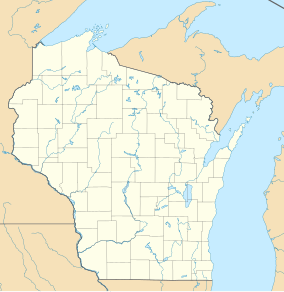| Vernon Wildlife Area | |
|---|---|
| Vernon State Wildlife Area | |
IUCN category V (protected landscape/seascape) | |
| Location | Waukesha, Wisconsin |
| Nearest city | Waukesha, Wisconsin |
| Coordinates | 42°54′51″N 88°17′30″W / 42.91417°N 88.29167°W |
| Area | 5,967 acres (24.15 km2) |
| Established | 1946 |
| Governing body | Wisconsin Department of Natural Resources |
The Vernon Wildlife Area is a 5,967-acre (2,415 ha) tract of protected land located in Waukesha County, Wisconsin, managed by the Wisconsin Department of Natural Resources (WDNR).[1] The first parcel of land to be used for the Wildlife Area was leased in 1946 to function as a public hunting ground, focusing primarily on small game and various game birds.[2] The Vernon Wildlife Area is one of ten state protected areas included in the Southern Kettle Moraine Region Planning Group, a WDNR classified area.[3]
Flora
There are 14 prominent tree species in the wildlife area, including one species non-native to the region and Wisconsin in general (Norway maple).[4] Native species include; shagbark hickory, black cherry, red maple, white ash, swamp ash, sugar maple, swamp birch, American basswood, eastern cottonwood, river birch, swamp white oak, silver maple, and American elm.[5][6][7]
Besides species of trees, there are seven major types of brush that may be found in the wildlife area, including buckthorn, honeysuckle, dogwoods, canary grass, reed grass, garlic mustard, and narrowleaf cattail.
Land cover
While the overall boundary of the area is measured at 5,967 acres (2,415 ha), only 4,330 acres (1,750 ha) are actually managed by the WDNR. An acquisition goal of 4,934 acres (1,997 ha) to be managed has been set by the WDNR.
| Cover type | Acres | Percent cover |
|---|---|---|
| Agriculture | 130 | 3% |
| Aspen | 215 | 5% |
| Bottomland hardwood | 75 | 2% |
| Conifer plantation | 10 | <1% |
| Developed | 15 | <1% |
| Grassland | 150 | 4% |
| Lowland shrub | 550 | 13% |
| Marsh/emergent wetland | 2,310 | 53% |
| Non-forested wetlands | 215 | 5% |
| Northern hardwoods | 100 | 2% |
| Oak | 185 | 4% |
| Oak savanna | 50 | 1% |
| Prairie | 10 | <1% |
| Swamp conifers | 20 | <1% |
| Upland shrub | 45 | <1% |
| Water | 250 | 6% |
| Total acreage | 4,330 | 100% |
Vernon Fen
The Vernon Fen is a Calcareous Fen located within the boundaries of the greater Wildlife Area. The Fen has an area of 13 acres (5.3 ha) and is a Native Community objective. The Fen features peat soil and sloping hills, complete with multiple types of sedges. The Fen is home to multiple small springs that feed into the Fox River. The Fen is characterized by beak-rush and short-headed rush (Juncus brachycephalus).[8][9]
Recreation
The Vernon Wildlife Area was founded with the intent to create public hunting grounds in Waukesha, and as such the WDNR has made keeping game populations steady a focal point of their preservation efforts. Opportunities for hunting and trapping of mourning doves, deer, ring-necked pheasant, and turkey are available.[10][11]
Fishing is also a popular activity according to the WDNR, with the Mill Brook (a passively managed Class 2 trout stream classed as an Exceptional Resource Water by the WDNR) being a key access point for trout fishing.[12]
References
- ^ WDNR Website Archived 2022-03-03 at the Wayback Machine- Retrieved 2022-03-23
- ^ WDNR Small game hunting Website Archived 2022-03-14 at the Wayback Machine- Retrieved 2022-03-23
- ^ Wisconsin Digital Archives Southern Region Planning Group Website Archived 2023-04-23 at the Wayback Machine- Retrieved 2022-03-25
- ^ WDNR Terrestrial Invasive species Website Archived 2020-08-15 at the Wayback Machine- Retrieved 2022-03-23
- ^ WDNR Chapter 47 Bottomland Hardwood Type Archived 2022-03-23 at the Wayback Machine- Retrieved 2022-03-23
- ^ WDNR Chapter 52 Central Hardwood Cover Type Archived 2022-11-02 at the Wayback Machine- Retrieved 2022-03-23
- ^ WDNR Chapter 40 Northern Hardwood Cover Type Archived 2022-03-23 at the Wayback Machine- Retrieved 2022-03-23
- ^ Biodiversity in Selected Natural Communities Related to Global Climate Change PDF Archived 2022-03-03 at the Wayback Machine- Retrieved 2022-03-23
- ^ WDNR Rapid Ecological Assessment for the Wildlife and State Natural Areas of the Southern Kettle Moraine Region PDF Archived 2017-02-10 at the Wayback Machine- Retrieved 2022-03-23
- ^ WDNR Ring-necked pheasant Website Archived 2022-03-25 at the Wayback Machine- Retrieved 2022-03-25
- ^ WDNR Small game hunting Website Archived 2022-03-14 at the Wayback Machine- Retrieved 2022-03-25
- ^ WDNR Trout stream classification Website Archived 2022-03-20 at the Wayback Machine- Retrieved 2022-03-25
External links
- U.S. Geological Survey Map at the U.S. Geological Survey Map Website. Retrieved March 20, 2022.
- Map of Vernon Wildlife Area at the WDNR Website. Retrieved March 23, 2022.
- Map of Trout Streams in Waukesha County at the WDNR Website. Retrieved March 25, 2022.


